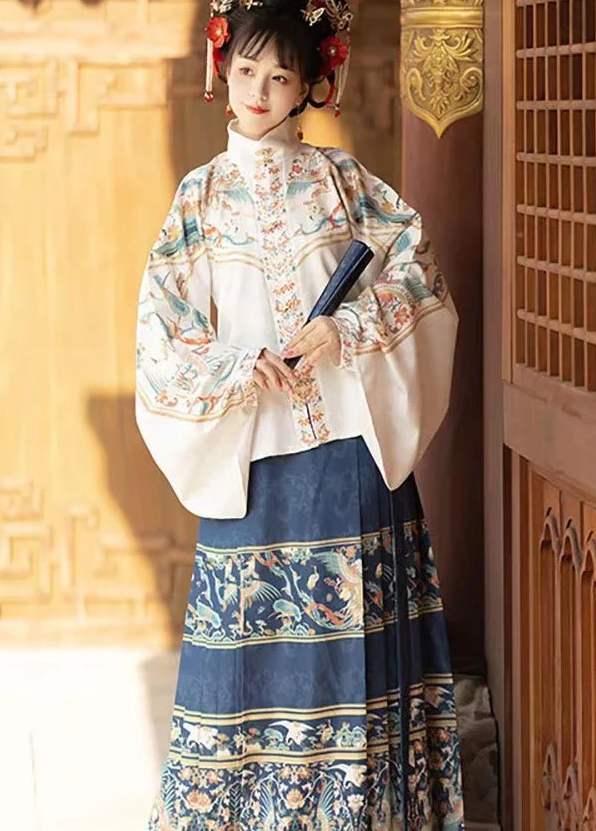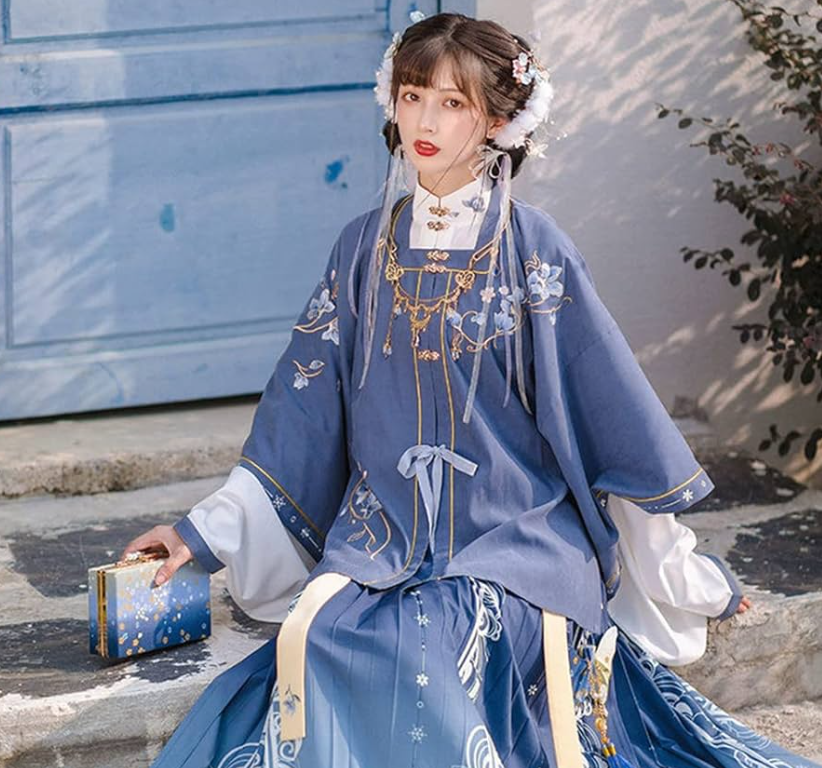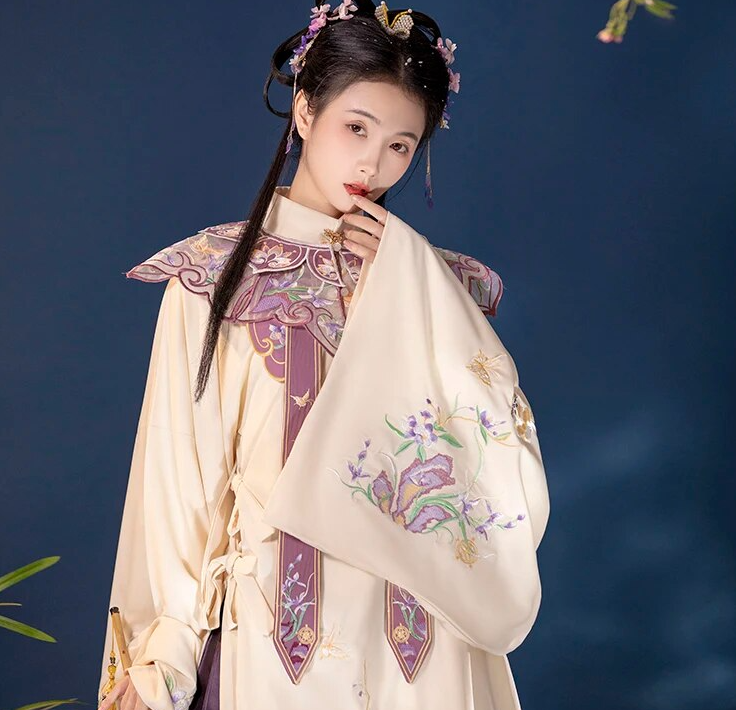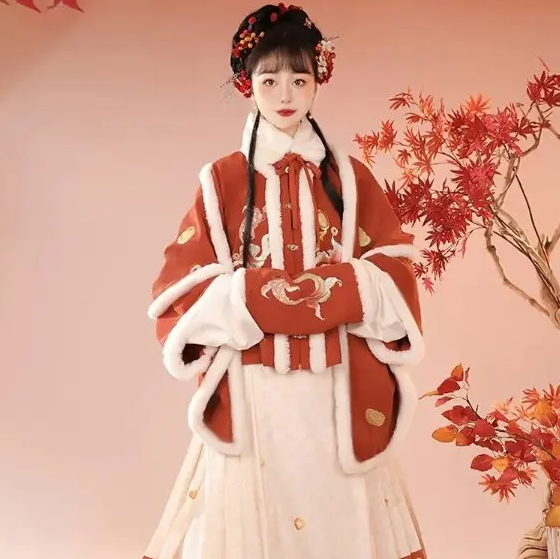Hanfu during the Ming Dynasty refers to traditional Chinese garments worn in the Ming era, characterized by vibrant colors, intricate embroideries, and specific designs.
Introduction
The Ming Dynasty, spanning from 1368 to 1644, represented a significant era in Chinese history. Known for its advancements in trade, art, and culture, the dynasty was a golden age in many respects. One of the most iconic cultural elements of the Ming Dynasty is the Hanfu, traditional Chinese attire that reflected the sartorial preferences, values, and aesthetics of the era.

Background of Ming Dynasty
The Ming Dynasty was founded by Emperor Hongwu after the collapse of the Yuan Dynasty. Under his leadership, and successive emperors, the dynasty saw massive urban and rural development. The Grand Canal was renovated, enhancing trade and transportation. The capital was moved from Nanjing to Beijing, where the majestic Forbidden City was constructed, spanning an area of about 180 acres with an estimated cost of 100 million silver taels.
A hallmark of the Ming era was the reinforcement of the Great Wall. An additional 8,850 kilometers were constructed, employing millions and at an estimated cost that exceeds billions in modern currency. Trade flourished with the voyages of Zheng He, leading to cultural exchange with distant lands.
Overview of Hanfu
Hanfu, translated as “Han clothing”, is the traditional dress of the Han Chinese people. Tracing its origins back to the Han Dynasty, its style and design have evolved over millennia. By the Ming Dynasty, the Hanfu had undergone several modifications, reflecting the aesthetics and values of the time.
Ming Dynasty Hanfu was distinct in its design, primarily made of silk, a material that signified wealth and status. The quality of the silk used was of the highest standards, with a smooth finish and vibrant colors. The dresses were adorned with intricate embroidery, often depicting nature, mythical creatures, and philosophical symbols. The most popular colors during this period were crimson, azure, and gold, each bearing specific cultural significances.
Different types of Hanfu were worn for different occasions. For instance, a ‘Shenyi’ was a formal attire, worn by scholars and officials, while an ‘Aoqun’ was more casual, often chosen by women for daily wear. Each type had its specific dimensions, with ‘Shenyi’ often being longer and more draped, while ‘Aoqun’ was more fitted.
One notable feature was the efficiency in design, as Hanfu was made to be comfortable for various activities, from formal ceremonies to daily chores. The prices varied greatly based on the quality of materials and intricacy of designs. A high-end Hanfu, made of the finest silk with detailed embroidery, could cost up to several hundred silver taels.
Evolution of Hanfu Prior to the Ming Dynasty
The evolution of Hanfu over centuries showcases the dynamic changes in Chinese culture, aesthetics, and socio-economic factors. Before the Ming Dynasty, the Hanfu had undergone numerous modifications, each dynasty introducing its unique flair and style.
Hanfu during the Tang Dynasty
The Tang Dynasty, lasting from 618 to 907, was an era known for its cultural and economic prosperity. During this period, Hanfu designs emphasized comfort, flexibility, and flamboyance.
The primary material for Hanfu in the Tang Dynasty was silk, which was woven with exceptional quality. Silk garments of this period were vibrant, often dyed in rich colors like royal blue, golden yellow, and jade green. The price of a high-quality silk garment could range from 50 to 100 silver taels, depending on its intricacy and craftsmanship.
Women’s Hanfu of this period often featured wide sleeves and high waistlines. The ‘Ruqun’, a blouse-skirt combination, became popular, with the skirt’s length varying, but often reaching the ankles. Men’s attire, on the other hand, was simpler, consisting of robes with broad belts.
One significant advantage of the Tang Hanfu was its adaptability. As trade flourished along the Silk Road, the Hanfu incorporated elements from Persia, India, and Central Asia, leading to diverse designs and patterns.
Hanfu during the Song Dynasty
Spanning from 960 to 1279, the Song Dynasty was an era of innovation and refinement. Hanfu during this period saw a move towards a more conservative and elegant style compared to the flamboyant Tang Dynasty.
Materials varied, with both silk and cotton being popular. Quality cotton garments, known for their durability and comfort, could be purchased for 20 silver taels, while silk garments, known for their sheen and elegance, ranged from 40 to 80 silver taels.
The ‘Beizi’, a knee-length tunic, became popular among women. For men, the ‘Shenyi’, a one-piece robe, became a standard choice. Colors during the Song Dynasty were generally more subdued, with preference given to whites, blacks, and grays, reflecting a philosophical shift towards Confucian values.
Hanfu during the Yuan Dynasty
The Yuan Dynasty (1271-1368) brought a fusion of Mongol and Han Chinese cultures. Hanfu during this period integrated various elements from Mongolian attire.
Silk remained the dominant material for the elites, while commoners often wore garments made of hemp or wool. A top-tier silk Hanfu could cost upwards of 90 silver taels, given the intricate Mongolian-inspired patterns.
The ‘Yuanlingshan’, a round-collared robe, became the official attire for men. For women, the ‘Qiyao skirt’, characterized by its high waist, was the popular choice. This period also saw the rise of decorative accessories, with belts, hats, and boots becoming significant parts of the ensemble.
Distinct Features of Ming Dynasty Hanfu
The Ming Dynasty, a significant era in Chinese history, brought about a renaissance in many cultural aspects, one of which was the Hanfu. The attire during this period was marked by its exquisite craftsmanship, elegance, and deep cultural symbolism. Let’s delve into the distinctive features that set Ming Dynasty Hanfu apart.
Materials and Fabric Used
During the Ming Dynasty, silk reigned supreme as the material of choice, especially for the elite. Its production involved meticulous care, with silkworms fed a strict diet of mulberry leaves to produce the finest threads. A high-quality silk Hanfu, known for its lustrous sheen and soft texture, could cost anywhere between 100 to 200 silver taels, making it a luxury item.
Apart from silk, other materials like cotton, hemp, and wool also found their way into Hanfu, especially for everyday wear. Cotton, for instance, was both affordable and comfortable, making it popular among commoners. A good quality cotton Hanfu would typically cost around 30 silver taels.
Color Preferences and Symbolisms
Colors in Ming Dynasty Hanfu were not just a matter of aesthetic preference but carried deep cultural and symbolic meanings. Crimson, for instance, was a favorite among the royals, symbolizing power and vitality. Azure, on the other hand, was often associated with scholars and the literati, representing calmness and wisdom. Gold was a symbol of wealth and prosperity, often used in Hanfu meant for special occasions.
Black and white, while less prominent, were also significant. Black, symbolizing the heavens, was occasionally worn by officials, while white, representing purity, was typically worn during mourning periods.
Patterns and Embroideries
The Ming Dynasty was a golden age for art and craftsmanship, and this was vividly reflected in the patterns and embroideries of Hanfu. Dragons, signifying imperial power, were often embroidered on the robes of emperors and high-ranking officials. Phoenixes, symbolizing grace and virtue, adorned the Hanfu of empresses and noblewomen.
Floral patterns, inspired by chrysanthemums, peonies, and lotuses, were also prevalent, each flower carrying its own symbolism. For instance, peonies, representing wealth and honor, were a common feature on the Hanfu of wealthy merchants and aristocrats.
The craftsmanship involved in these embroideries was unparalleled. A single piece of Hanfu with intricate embroidery could take months to complete, adding significantly to its value. The cost for such detailed work could increase the price of the Hanfu by 50 to 100 silver taels.

Different Types of Hanfu during the Ming Dynasty
The Ming Dynasty, celebrated for its rich cultural tapestry, further developed the Hanfu, introducing varied styles and designs. Each type of Hanfu served a specific purpose, be it daily wear, ceremonial attire, or fashion statements. These distinct styles not only emphasized the aesthetics of the era but also showcased the intricate craftsmanship and diverse functionalities.
Shenyi (深衣)
The Shenyi, a formal attire, signified elegance and respect. Typically crafted from high-quality silk, it was a one-piece robe that integrated both the upper garment and the skirt. The entire piece was seamlessly connected, symbolizing the unity of heaven and man.
Given its status as a formal wear, Shenyi often featured exquisite embroidery, with prices ranging from 120 to 250 silver taels based on the intricacy of the designs. Worn primarily by scholars, officials, and the literati, the Shenyi was a testament to one’s social standing and intellectual prowess.
Aoqun (袄裙)
The Aoqun was a two-piece attire, consisting of a blouse (‘Ao’) and a skirt (‘Qun’). Predominantly chosen by women for daily activities, the Aoqun was both stylish and practical. The blouse typically had a straight collar and was fastened on the right side, while the skirt was often pleated for ease of movement.
Silk was the primary material for the elite, but cotton versions were also widespread. Depending on the material and craftsmanship, an Aoqun’s price could vary between 40 to 150 silver taels.
Beizi (褙子)
Originating from earlier dynasties and gaining popularity in the Ming era, the Beizi was a knee-length tunic worn over skirts or trousers. With wide sleeves and side slits for better movement, it was favored by both men and women.
The Beizi often bore intricate patterns and embroidery, with nature-inspired themes being predominant. Prices varied based on design and material quality, ranging from 50 to 180 silver taels.
Pifeng (披风)
The Pifeng, akin to a cloak or cape, was an overgarment draped over the shoulders. Serving both as a fashion accessory and a protective layer against the elements, it was common among both genders. Crafted usually from thicker materials during winters and lighter fabrics like silk during summers, the Pifeng was versatile.
Elegantly designed Pifengs, especially those made for ceremonies or special events, could feature ornate embroideries of dragons, phoenixes, or other auspicious symbols. These intricately crafted Pifengs could cost anywhere from 70 to 200 silver taels, depending on their complexity and the quality of the material used.

Social and Cultural Implications of Hanfu
Hanfu, beyond being just a form of clothing, encapsulates the socio-cultural essence of Chinese civilization. Particularly in the Ming Dynasty, Hanfu became more than a fashion statement—it was an embodiment of societal values, hierarchy, and artistic inclinations. Let’s explore the profound social and cultural implications of this iconic attire.
The Role of Hanfu in Ming Dynasty Society
In the bustling world of the Ming Dynasty, Hanfu was integral in defining roles and relationships. Every layer, fold, color, and embroidery conveyed messages about the wearer’s occupation, social status, and even personal beliefs. For instance, government officials had specific attire, distinguishable by intricate embroidery, denoting their rank and function.
Furthermore, Hanfu was also instrumental during important life events. From birth to death, specific types of Hanfu were designated for ceremonies like weddings, funerals, and coming-of-age rituals. These garments played crucial roles in marking transitions and milestones in one’s life.
Hanfu as a Symbol of Status and Identity
The choice of material, quality of craftsmanship, and even the colors of Hanfu were reflective of a person’s socio-economic status. Silk, with its sheen and luxury, was typically reserved for the affluent. A high-quality silk Hanfu could fetch a price of 150 to 250 silver taels, while cotton or hemp variants, worn primarily by commoners, could be acquired for 20 to 50 silver taels.
Moreover, certain designs and colors were exclusive privileges of the royalty and nobility. For instance, bright yellow was a color often reserved for the emperor, symbolizing his divine connection to the heavens. Wearing it without the appropriate status could invite severe consequences.
Cultural and Artistic Influences on Hanfu Design
Art and culture of the Ming era deeply influenced Hanfu designs. Philosophical beliefs, especially those derived from Confucianism and Daoism, were woven into the fabric, both metaphorically and literally. Symbols like the dragon, representing cosmic power and imperial authority, or the phoenix, symbolizing high virtue and grace, were commonly featured.
Literary works, poems, and paintings of the era also played a role in shaping Hanfu aesthetics. Poetic verses from famed poets like Li Bai or Du Fu were sometimes embroidered onto garments, marrying the world of literature with fashion.
Comparison with Other Dynastic Hanfu
Hanfu, as the traditional attire of the Han Chinese, has seen numerous evolutions, modifications, and nuances throughout China’s long history. Each dynasty added its flavor, refining the style, materials, or patterns. When looking at the Hanfu from the Ming Dynasty, it’s enlightening to juxtapose it with its predecessors, such as the Tang and Song Dynasties, as well as understand its influence on subsequent eras.

Differences from Tang and Song Dynasty Hanfu
Tang Dynasty Hanfu: The Tang Dynasty is often considered a golden age of Chinese culture, and its influence on Hanfu is undeniable. Hanfu from this era was characterized by its liberal and flamboyant styles. Women’s dresses, such as the “Da Lian”, had high waists, large sleeves, and were worn with scarves. The freedom and openness of Tang society were reflected in the bold and colorful designs, as well as the adoption of foreign elements due to the extensive trade and interaction along the Silk Road. Tang Hanfu was less restrictive, with a preference for wider sleeves and lower collars, allowing for more ease of movement and a freer aesthetic.
Song Dynasty Hanfu: The Song Dynasty brought with it a more conservative shift. The Hanfu during this period saw narrower sleeves and higher collars, reflecting a more reserved societal demeanor. The influence of Confucianism played a role in this, emphasizing modesty and restraint. Layering became prominent during this era, with multiple robes worn one over the other. Song Dynasty Hanfu was also marked by its softer colors, in contrast to the vibrant palette of the Tang era.
Compared to these two, Ming Dynasty Hanfu was a blend of the traditional and the innovative. While it maintained the conservative nature from the Song, it also incorporated specific design elements from the Tang. However, it set itself apart with its distinctive cut, embroidery techniques, and the use of more complex patterns and symbols.
Influence on Later Dynasties’ Hanfu
The Ming Dynasty’s impact on subsequent dynasties, particularly the Qing, was profound. Although the Qing Dynasty, being of Manchu origin, initially promoted the Manchu style of clothing, the influence of Ming Hanfu was evident in the designs, especially among the Han Chinese populace.
Qing-era robes, for instance, showcased a blend of Manchu designs with patterns and embroidery techniques inherited from the Ming period. The silhouette of the Ming Hanfu, with its flowing robes and distinct sleeves, can also be seen influencing the Hanfu variants in the early Qing before the widespread adoption of the Manchu qipao and changshan.
Furthermore, the Ming Dynasty’s emphasis on symbolism in Hanfu, where garments conveyed societal position, identity, and values, persisted in the Qing and even beyond, into modern interpretations of traditional Chinese attire.
Modern Revival of Ming Dynasty Hanfu
In recent decades, there has been a significant surge in the interest and appreciation of traditional Chinese culture, particularly the Hanfu. The Ming Dynasty, given its rich tapestry of design and symbolism in Hanfu, stands out as one of the most influential periods in this revival. This modern resurgence isn’t just about wearing traditional clothes; it’s also about reconnecting with historical and cultural roots.
Hanfu Movement in the 21st Century
The Hanfu Movement began around the early 2000s, primarily fueled by a younger generation of Chinese looking to reconnect with their heritage. Social media platforms, especially those centered around photo-sharing, played a pivotal role in popularizing this movement.
- Popularity: Hanfu festivals, workshops, and conventions started springing up across major cities in China. By 2020, the number of Hanfu enthusiasts was estimated to be around 2 million, a significant jump from just a few thousand in the early 2000s.
- Economics: The revival wasn’t just a cultural phenomenon; it also had economic implications. The market value of the Hanfu industry reached a staggering 1.09 billion USD in 2019, showcasing its growing appeal.
- Youth Involvement: Contrary to what one might expect, a majority of the Hanfu enthusiasts are young people, often in their teens or twenties. They see it not just as a fashion statement but as a means of self-expression and a reflection of national pride.
Influence of Ming Dynasty Hanfu on Contemporary Fashion
The Ming Dynasty’s styles, designs, and patterns have made a visible mark on modern fashion, especially in China.
- High Fashion Integration: Many contemporary Chinese fashion designers have incorporated Ming Dynasty elements into their collections. The intricate embroideries, flowing silhouettes, and vibrant colors of the Ming era can be seen on runways, not just in China but globally.
- Everyday Wear Adaptations: While the traditional Hanfu might be elaborate for daily wear, many brands have launched modern adaptations that are more practical. These include Ming-inspired shirts, jackets, and dresses, which retain the essential aesthetic elements while being suited for daily use.
- Global Appeal: Ming Dynasty Hanfu, with its unique blend of tradition and elegance, has caught the attention of international fashion enthusiasts. It’s not uncommon now to see Hanfu-inspired pieces in fashion hubs like Paris, Milan, and New York.